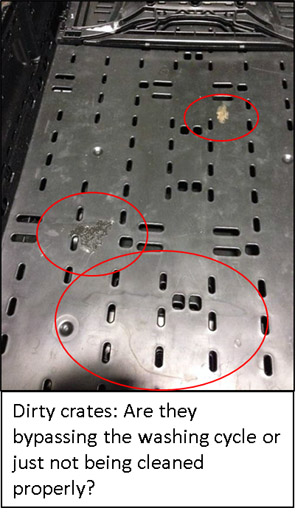PPEC: Corrugated Boxes Beat Reusable Crates for Cleanliness

Retailers are being urged to "follow the science" on sanitization by the Paper & Paperboard Packaging Environmental Council, Brampton, Ontario, Canada (PPEC). PPEC Executive Director John Mullinder wrote a statement on behalf of the council after learning more about how the corrugated box industry is supposedly is fear-mongering about food safety problems after a PPEC-member company recently received an emergency call to supply corrugated boxes because the reusable crates that had arrived were moldy and unusable. The following is the text of his statement:
"The corrugated box industry is just fear-mongering about food safety, according to the reusable crate lobby, which has obviously been stung by the release of yet another study questioning whether, and how well, crates are being cleaned between uses.
"The latest study by Dr. Steven Ricke’s team at the Department of Food Science at the University of Arkansas demonstrates that typical industry cleaning procedures don’t actually sanitize the crates. Salmonella cells remained on the crates after cleaning. The authors suggest that bacterial biofilms hide in the cracks and crevices of the crate’s surface, making it harder for industrial sanitizers to reach them.
"Dr. Ricke says industry claims that crates are "99.5%" clean after sanitization sound impressive, but that the missing 0.5% could hold a lot of cells that could cause a lot of trouble. All it needs is one cell to multiply, to spoil product, to transfer to the next batch of fresh produce, to make someone sick or cause premature spoilage.
"Any promises to remove pathogens or micro-organisms from reusable packaging that’s carrying food, he says, are not based on data. "The only guarantee that’s valid from a scientific standpoint is (that) these cells cannot be removed using commercial methods or materials." To eliminate that risk of contamination, Ricke recommends shippers use single-use rather than multi-use packaging.
"The crate industry has fired back at Ricke’s latest work, saying that "laboratory experiments" and results are no indicator of real-world realities. Point taken. But that doesn’t mean a problem doesn’t exist. Dr. Keith Warriner’s real-world studies in Ontario and Quebec in 2013-2014 strongly suggested that crates being re-used in Canada were either bypassing the washing facility in Chicago entirely or not being washed properly when they got there. E. coli was found on 13% of the crates tested. And here’s another real-world experience. A PPEC-member company recently received an emergency call to supply corrugated boxes because the crates that had arrived were moldy and unusable.
"It’s way past time for all the interested parties to agree to an independent study to establish a credible baseline for sanitization testing. Is the crate lobby willing to participate?"
TAPPI
http://www.tappi.org/
 Retailers are being urged to "follow the science" on sanitization by the Paper & Paperboard Packaging Environmental Council, Brampton, Ontario, Canada (PPEC). PPEC Executive Director John Mullinder wrote a statement on behalf of the council after learning more about how the corrugated box industry is supposedly is fear-mongering about food safety problems after a PPEC-member company recently received an emergency call to supply corrugated boxes because the reusable crates that had arrived were moldy and unusable. The following is the text of his statement:
Retailers are being urged to "follow the science" on sanitization by the Paper & Paperboard Packaging Environmental Council, Brampton, Ontario, Canada (PPEC). PPEC Executive Director John Mullinder wrote a statement on behalf of the council after learning more about how the corrugated box industry is supposedly is fear-mongering about food safety problems after a PPEC-member company recently received an emergency call to supply corrugated boxes because the reusable crates that had arrived were moldy and unusable. The following is the text of his statement: